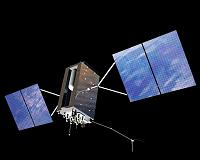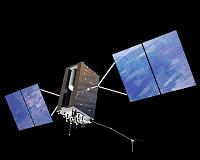After a successful launch this afternoon, the third Lockheed Martin-built GPS III satellite is now headed to orbit under its own propulsion. The satellite has separated from its rocket and is using onboard power to climb to its operational orbit, approximately 12,550 miles above the Earth.
GPS III Space Vehicle 03 (GPS III SV03) is responding to commands from U.S. Space Force and Lockheed Martin engineers in the Launch and Checkout Center at the company’s Denver facility. There, they declared rocket booster separation and satellite control about 90 minutes after the satellite’s 4:10 p.m. EST launch aboard a SpaceX Falcon 9 rocket from Cape Canaveral Air Force Station, Florida.
“In the coming days, GPS III SV03’s onboard liquid apogee engines will continue to propel the satellite towards its operational orbit,” said Tonya Ladwig, Lockheed Martin’s Acting Vice President for Navigation Systems. “Once it arrives, we’ll send the satellite commands to deploy its solar arrays and antennas, and prepare the satellite for handover to Space Operations Command.”
After on-orbit testing, GPS III SV03 is expected to join the GPS constellation – including GPS III SV01 and SV02, which were declared operational in January and April – in providing positioning, navigation and timing signals for more than four billion military, civil and commercial users.
Lockheed Martin designed GPS III to help the Space Force modernize the GPS constellation with new technology and capabilities. The new GPS IIIs provide three times better accuracy and up to eight times improved anti-jamming capabilities over any previous GPS satellite. They also offer a new L1C civil signal, which is compatible with other international global navigation satellite systems, like Europe’s Galileo, to improve civilian user connectivity.
GPS III also continues the Space Force’s plan to field M-Code, a more-secure, harder-to-jam and spoof GPS signal for our military forces. GPS III SV03 brings the number of M-Code enabled satellites to 22 in the 31-satellite GPS constellation.
“As a nation, we use GPS signals every day – they time-stamp all our financial transactions, they make aviation safe, they make precision farming possible, and so much more. GPS has become a critical part of our national infrastructure.
In fact, the U.S. economic benefit of GPS is estimated to be over $300 billion per year and $1.4 trillion since its inception,” added Ladwig. “Continued investment in modernizing GPS – updating technology, improving its capabilities – is well worth it.”
Lockheed Martin is proud to be a part of the GPS III team led by the Space Production Corps Medium Earth Orbit Division, at the Space Force’s Space and Missile Systems Center, Los Angeles Air Force Base. The GPS Operational Control Segment sustainment is managed by the Enterprise Corps, GPS Sustainment Division at Peterson Air Force Base.
The 2nd Space Operations Squadron, at Schriever Air Force Base, manages and operates the GPS constellation for both civil and military users.
Flying in Space, Ground Control and More M-Code
Space Force and Lockheed Martin engineers are currently controlling GPS III SV03’s launch and checkout test from Lockheed Martin’s Launch and Check Out Center in Denver using elements of the GPS Next Generation Operational Control System (OCX) Block 0. Satellite control and operations are expected to shift to the Space Force’s current Operational Control Segment (OCS) ground control system at Schriever Air Force Base later this year.
Until the Space Force’s next generation ground control system is ready, Lockheed Martin has been helping sustain the OCS with a series of software upgrades, including the Red Dragon Cybersecurity Suite and GPS III Contingency Operations (COps) upgrade, which allowed the system to control the more powerful GPS III satellites and received formal Operational Acceptance in March.
In early June, Lockheed Martin installed the M-Code Early Use (MCEU) upgrade on the OCS. Expected to be operational by yearend, the MCEU upgrade will help accelerate M-Code’s deployment in order to support testing and fielding of modernized user equipment for our warfighters.
GPS III In Full Production
Satellite production continues at a rapid pace at Lockheed Martin’s GPS III Processing Facility near Denver. Currently the commercial-like production line, has seven satellites moving through work cells, from assembly… to test… to storage, before they ship to the Cape.
GPS III SV 04 and SV05 are completed, already declared “Available for Launch” by the Space Force, and waiting to be called up. GPS III SV06, SV07 and SV08 are completely assembled space vehicles on the production floor and are currently going through post-assembly and environmental testing. GPS III SV09 and SV10 are in component build up.
GPS IIIF
Lockheed Martin has also begun work on the GPS III Follow On (GPS IIIF) program, which could add up to 22 additional GPS IIIF satellites with additional capabilities. In March, the GPS IIIF program completed its Critical Design Review (CDR).
GPS IIIF builds off the existing modular GPS III, which was designed to evolve with new technology and changing mission needs. GPS IIIF will add a new Regional Military Protection Capability, a fully digital navigation payload, an accuracy-enhancing laser retro-reflector array and a new Search and Rescue payload.
For GPS IIIF the Lockheed Martin team is leaning forward, exploring ways to use innovative tools, like Augmented Reality and paperless digital reviews, to enhance satellite development and production. We also are implementing our modernized LM 2100 satellite bus, which drives further efficiency and cost-reduction through more commonality of processes and procedures.
Related Links
GPS at Lockheed Martin
GPS Applications, Technology and Suppliers
|
Thanks for being here; We need your help. The SpaceDaily news network continues to grow but revenues have never been harder to maintain.With the rise of Ad Blockers, and Facebook – our traditional revenue sources via quality network advertising continues to decline. And unlike so many other news sites, we don’t have a paywall – with those annoying usernames and passwords.Our news coverage takes time and effort to publish 365 days a year.If you find our news sites informative and useful then please consider becoming a regular supporter or for now make a one off contribution. |
||
|
SpaceDaily Contributor $5 Billed Once |
SpaceDaily Monthly Supporter $5 Billed Monthly paypal only |
|
Beidou system sees wide application across the country
Beijing (XNA) Jun 24, 2020
China’s domestically developed Beidou Navigation Satellite System has been widely used in many public and private fields at home and abroad, according to official figures.
By the end of 2019, more than 100 million Beidou-based navigation chips, modules and other products had been sold, according to statistics released by the China Satellite Navigation Office.
At the same time, the system had been applied to nearly 6.6 million taxis, buses and trucks around China, as well as more than 70,000 … read more
– Advertisement –


